
Generations come and generations go. And with them, come changes. Changes that, in fact, affect the way we do sports. Generation X saw the invention of the internet. And we all know how important it has become. With Generation Y, millennials, came the invention of social media platforms. And of course now, Generation Z has become the first generation to be born into a fully digital world. The only constant in life, and in sports, is truly change. While I cannot predict the future and tell you what is to come, I can look at the data and tell you what is happening now and how this will affect the future. So let’s discuss the future sports trends happening now and what you should do about them.
Before we dive right in...
Subscribe to our blog today to ensure that you never miss valuable posts such as this one. We are passionate about helping sports organizations deliver a world-class fan experience, because better fan experience means better business. So why not use this opportunity to the fullest?


The battle for fans and fan engagement
First up on the future trends of sports happening now is the battle for fans. This is already happening and will only intensify with time. Back in the day, sports were like a religion. A family, a community or a town would pledge alligience to a team and support that team for generations. It didn’t matter whether the team lost or won, fans were loyal. However, that has started to change. Here are some changes worth mentioning:
- Gen Z no longer solely follow teams – they instead identify with the athletes themselves – and are more likely to root for the person, no matter the team the person is with.
- Media consumption, even when a big match is on, is becoming the norm. The general population has increased its multi-screen viewing activities (social media, texting, playing games, ordering food) by an average of 5%.
- Sports betting is exploding in the US, with Americans having already bet $125bn since 2018 – when states first began leagalizing sports betting.
- The prospect of having decentralized autonomous organizations (DAO) in sports. These are member-owned communities without centralized leadership. Essentially having internet-native sports organizations that are collectively owned and managed by its members.
- Of course, block chain, tokenization and web 3.0 are booming in sports too at the moment (which we will discuss briefly in this blog post as it is one of the hottest future sports trends)
All of these trends, and more, are taking place in the name of increasing fan engagement. But why this “sudden” lunge into new ways of engaging with fans?
Reasons for this
There are many reasons why this is one of the hottest future sports trends to start taking seriously. These include:
- The mere fact that the world is becoming more and more digital. There is someone always thinking of new ways to innovate. This is fantastic for the fans and the sports industry itself because it means more access, content, improvement and growth. But for sports organizations, I understand that it might, at first at least, feel like a pain.
- Sports organizations are losing their status as a sacred entity that fans follow no matter what. So, they have to compete. And not necessarily with other sports organizations, but rather with other industries. For example, will a fan choose to watch a show on Netflix or go to the stadium to watch your game?
- Paradoxically, sports fans are hungry for more content. Just because sports organizations nowadays have to earn their fans’ allegience does not mean that fans are not interested.
- Access – tokenization, block chain, DAO and web 3.0 allow fans to have full access to sports properties and assets instead of having to go through middlemen and gatekeepers.
So, there is a clear change happening right now in the way that sports organizations have to approach their fans. This makes fan engagement one of the most crucial future sports trends to run with.
And how can you do that?
How to leverage the trends in fan engagement

Every sports organization is different and therefore, you must not just copy a strategy just because it seems to be working for that organization. I repeat. Do not copy another sports organization’s strategy. What should you do instead? Use your supporter data to uncover the opportunities you should be leveraging.
For example: Let’s say most of your supporters are of the older generation and care more about being in the stadium than watching games online. It would not make sense to then suddenly use block chain to drive engagement. But does this mean you don’t innovate at all? Not at all. Thats why it’s even more important that you use supporter data because it might show you exactly how to bridge this apparent gap. But how can you get started using supporter data, today?
Use supporter data to drive fan engagement today
I will not beat around the bush, you need a sports customer data platform (CDP) to do this. A CDP, will not only help you increase your fan engagement, but it will help you to:
- future-proof your sports organization (the very subject of our discussion here)
- increase revenue
- catapult your supporter lifetime value
- eliminate all blind spots by giving you 360-degree supporter view
- give you a 360-degree approach to all your sports marketing
The reason it’s so paramount that you use a sports CDP when tackling one of the hottest future sports trends ever, battling for fans and fan enagement is that, you need to understand your fans before you can try to engage with them. And you can only do this effectively by collecting data using the CDP.
Why collecting data using a CDP is the best way to go
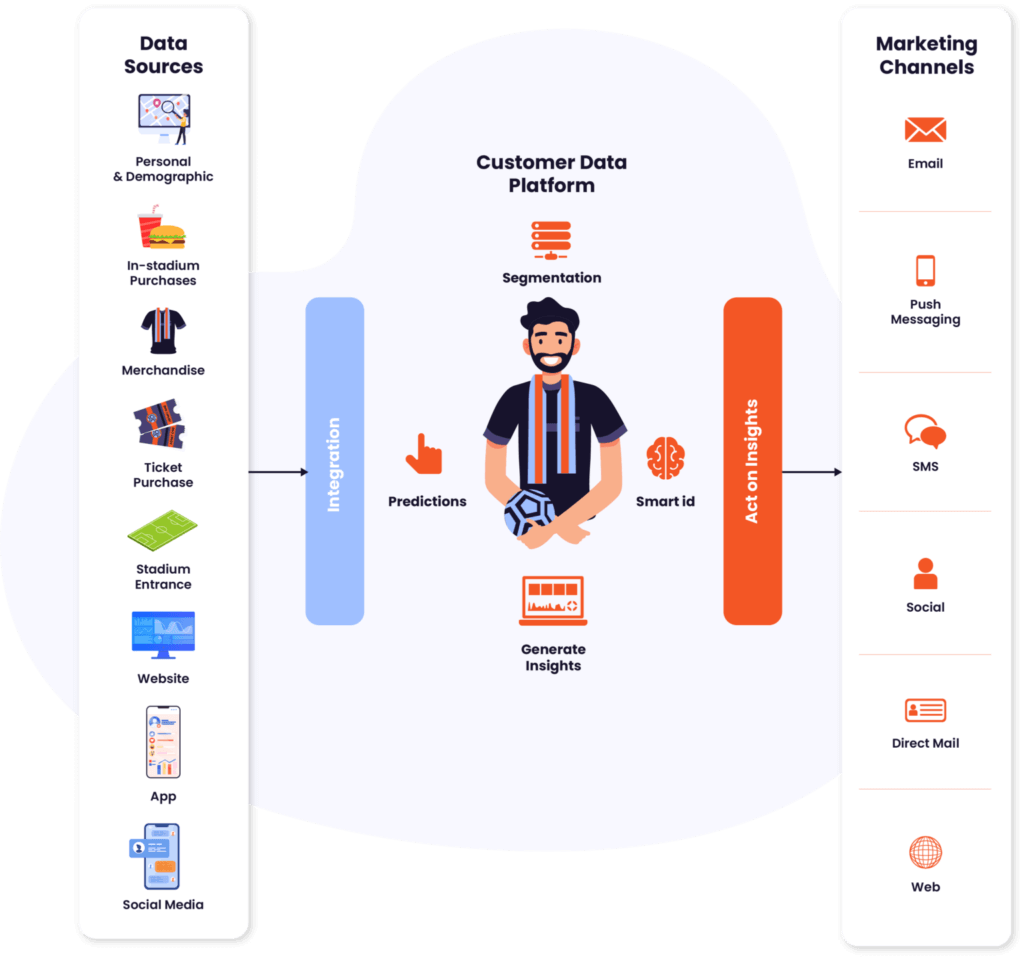
By using a CDP to collect data, you:
- Get a 360-degree supporter view. This allows you to understand your supporters fully. So you can uncover all the opportunities, now and in the future, that are perfectly aligned with them. This is a win-win situation becuase you keep them happy. And happy supporters means higher engagement.
- Can easily share your data with anyone who needs it, within the department and organization and even outside. Data transparency, the ability to easily share data, is one of the biggest problem that only the CDP was created to solve. This will help you and your team get creative with your data without wasting time and exerting unnecessary effort.
- Can be confident that the data is clean and up-to-date. Other data collection tools, such as a customer relationship management (CRM) system are limited in this area. For example, with the CRM, you have to manually upload the data it’s not always up to date. With the CDP, you are assured that your data is up-to-date since it automatically updates data with every new supporter interaction.
There is no bypassing the need for a CDP with this trend. Trying to adopt and reap all the benefits of blockchain, content, web 3.0 etc without first knowing what your supporters want will lead to many disappoints. These can include, low engagement and losing money, time and effort.
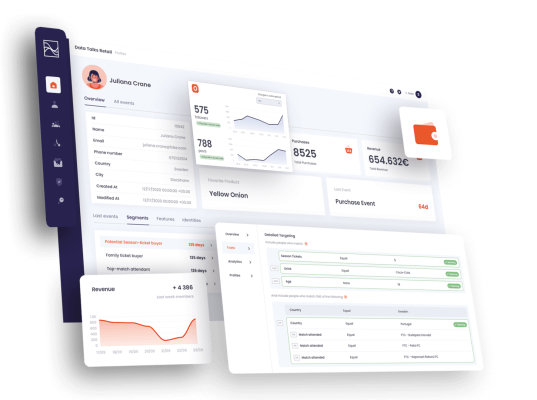
To see how this would look in action, explore the Data Talks CDP demo >>

Web 3.0
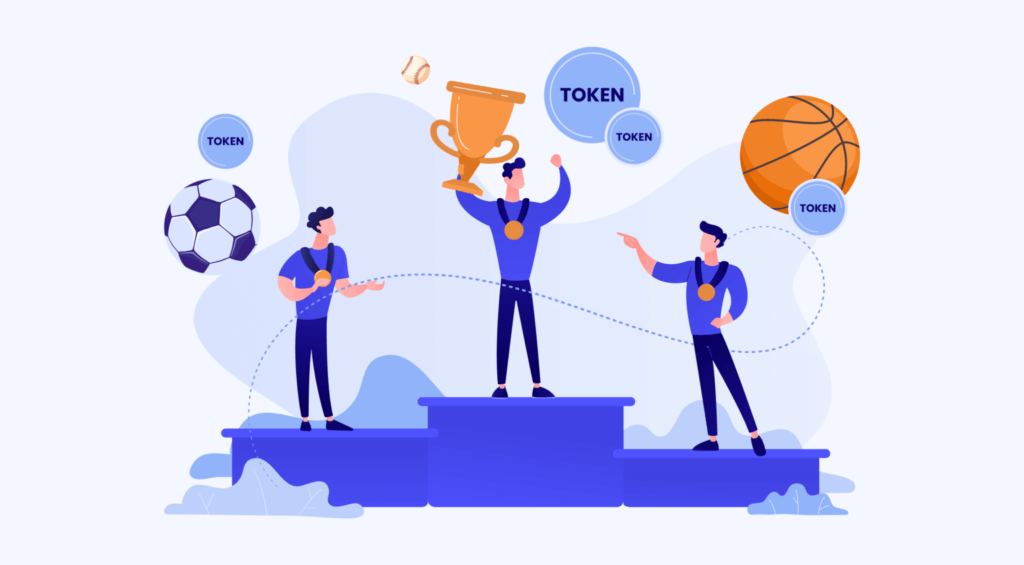
This is one of the hottest future sports trends of the moment. From NFTs to blockchain to tokens, a lot of sports organizations have started taking advantage of this to increase their fan engagement. Let’s look at a few basic definition of terms to ensure that we are all on the same page.
What is web 3.0?
This is the third generation of how we can use the internet. First we had web 1.0 which had limited use. This included static pages with content served from the server’s file system. Web 2.0 emphasized user generated content and usability. This was charaterized by dynamic content that is responsive to user input and information that flows between the site owner and site users using evaluation & online commenting (Geeks for Geeks). Web 3.0 is still developing as we speak so there isn’t a canonical working definition as of yet. But web 3.0 is characterized by:
- a strong emphasis on decentralized applications and make extensive use of blockchain-based technologies
- use of machine learning and artificial intelligence (AI) to help empower more intelligent and adaptive applications
- the notion of a semantic web – making the internet data machine-readable (data strikes again you see)
What is a blockchain?
A blockchain is essentially a digital ledger of transactions that is duplicated and distributed across the entire network of computer systems on the blockchain. Each block in the chain contains a number of transactions, and every time a new transaction occurs on the blockchain, a record of that transaction is added to every participant’s ledger (Euromoney).
What is an NFT?
Non-fungible token. Non-fungible meaning, it’s one of a kind and can’t be replaced with something else. NFTs are a blockchain property and can be traded.
Don’t get lost in the terminology
Although web 3.0 is indeed one of the best future sports trends unfolding right in front of our eyes, it can get confusing. Especially because this is completely new technology with new jargons. Additionally, this is a far cry from the traditional sports revenue model that we are used to. So it can seem overwhelming. But that is why we wanted to break it down for you. So let’s do that by looking at a few examples of how other sports organizations have been using web 3.0 to their advantage.

Why Sports Organizations need a CDP to grow and thrive

Women in sports: beyond the hashtag – time to make a difference
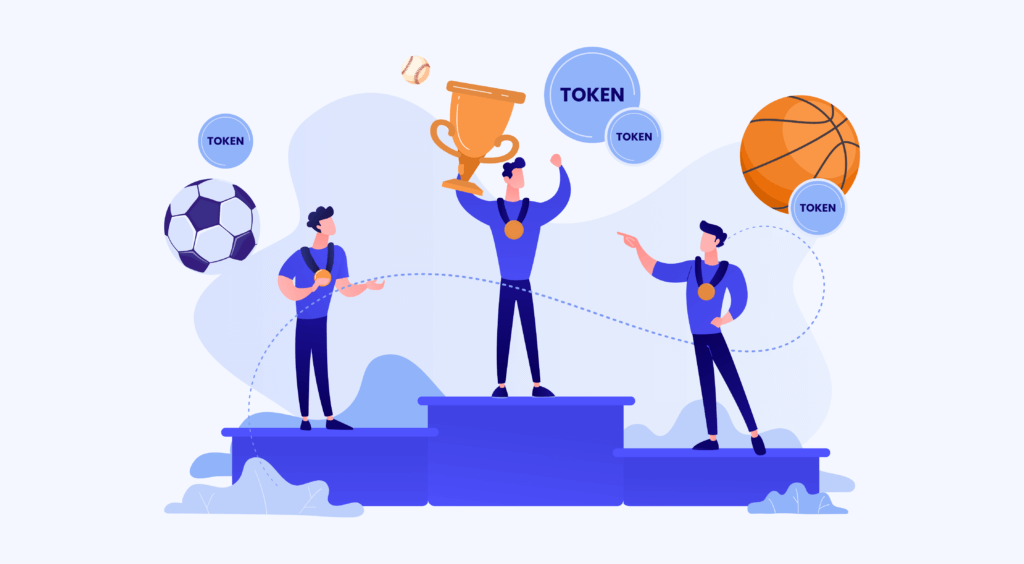
Everything You Need to Know About NFTs in Sports
Examples of how sports organizations have been using web 3.0
Manchester United and Tezos Partnership
Manchester United announced a multi-year partnership deal with Tezos – “an open source Proof of Stake blockchain that is energy efficient, security-focused, and seamlessly upgradable” (Tezos). Their partnership will:
- introduce Manchester United fans to Web3 technology through the Tezos blockchain
- include several new fan experiences
- support Manchester United Foundation with ongoing donations in tez, the native currency of the Tezos blockchain, to train, educate and inspire young people within the local community
From the aims of the partnership, one can clearly deduce that the emphasis is indeed on fan engagement, which we discussed above.
Angel City FC and Crypto.com
The aim of this partnership was to:
- celebrate the team’s achievements e.g. the first time the team took the pitch
- educate the community on the development of Web 3.0, cryptocurrencies, NFTs, and all other activities in this space
- help ensure everyone feels welcome, well-versed, and part of the Web3 and ACFC communities and
- ensure that community can leverage the learnings to make informed decisions about their involvement in the evolving category.

“We created this NFT collection to commemorate the kickoff of our first season and to use our platform to bring as many ACFC fans as possible into the exciting world of Web3, cryptocurrencies, and NFTs. We believe that ownership is a core tenet of Web3 and why NFTs are so powerful. Upon claiming the NFTs, our fans will own a piece of the team’s history and come on the journey alongside us. This is only the beginning”
– Julie Uhrman | Co-founder and President, Angel City Football Club
Here’s an example of how sports organizations can use NFTs
Clubs can make use of NFTs in sports to make some of their assets more accessible, for example. They can increase fan engagement in areas that weren’t possible before by accessing secondary markets of trading. Imagine that you, in a post-match ceremony, invite a group of fans who have earned certain rights through voting in important matters to the club. Now they have access to these assets, and therefore the possibility to attend these exclusive events. This allows for the supporter’s privilege to be tokenized into an NFT. So they can now sell it to other people if they want, which was previously very difficult to do.
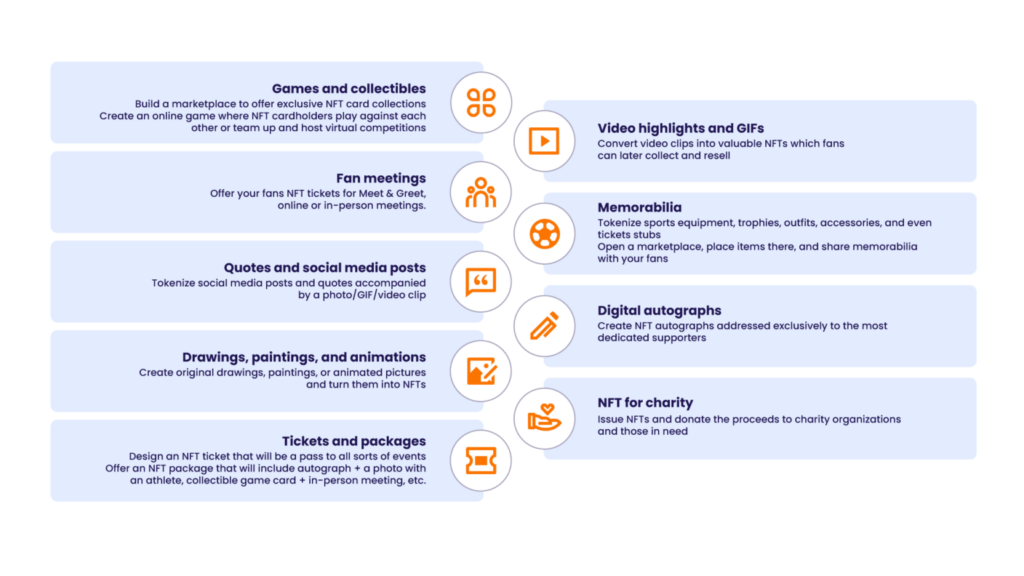

Digitalization and globalization will continue to grow in sports
With the world’s increased focus on everything digital, sports will only continue to become more digital and global. Web 3.0, that we discussed above, is indeed an example of this. Fandom is no longer limited to local and national communities but rather the whole world. This is nothing new in sports though. Clubs like Manchester United and Barcelona have been reaching global fans for a while now. However, with the increased focus on digital within sports, for all sports organizations and not jut the bigger ones, this trend has become one of the most crucial sports trends to keep an eye out for.
Globalization and digitalization are huge opportunities for sports organizations because they:
- help broaden a sports organization’s fan base increasing the likelihood of higher engagement and monetization
- present new digital opportunities for interacting with fans, e.g. the blockchain technology that we discussed above and over-the-top (OTT) streaming services
- help an organization with their branding (another important element that we won’t go into details in this post).
There are many trends out there but the rapid growth in digitalization and globalization is one of the best future sports trends happening right now. And this will only grow.
However, with great power comes great responsibility
With this great power and access to a global audience, that digitalization and globalization present, there is a greater need for diversity and inclusion.
- Angel City FC and Manchester united for example, use blockchain to educate their communities. This fills what is known as the education gap – the difference in achievement between learners with varying levels of advantage throughout their learning development.
- The need for representation becomes greater. Creating opportunities for women in sports for example is something crucial.
- Including underepresented and underserved communities such as people of color, people in non-mainstream regions is also something to bear in mind.
Conclusion
There are many future sports trends unfolding today. We would not be able to fit them all here, if we had to explore all of them. But do you know why I chose these three? Because the rapid change in fan behavior is one of the most definitively vital future sports trends today. Without fans, there would be no sports. So it is important to prioritize them. But like I said at the beginning of this post, the only constant in life is change. So even though trends like web 3.0 are quite hot and hip right now, there might be new innovation that comes in a few years. So my advice, be vigilent and watchful.
Not in a scary way, but rather in an easy practical way. To do this, you simply have to work data driven. Because then and only then, will you be able to identify all the future sports trends that you should be jumping on. Because let’s face it, not all fans are interested in NFTs and digital, even if they are in the minority.
So if you want to understand:
- what your supporters want
- how they want it
- where they want it
- and how you can fulfill these wants, then …
Start using a CDP today so you can be ahead of the trends and not behind – struggling to catch-up.
